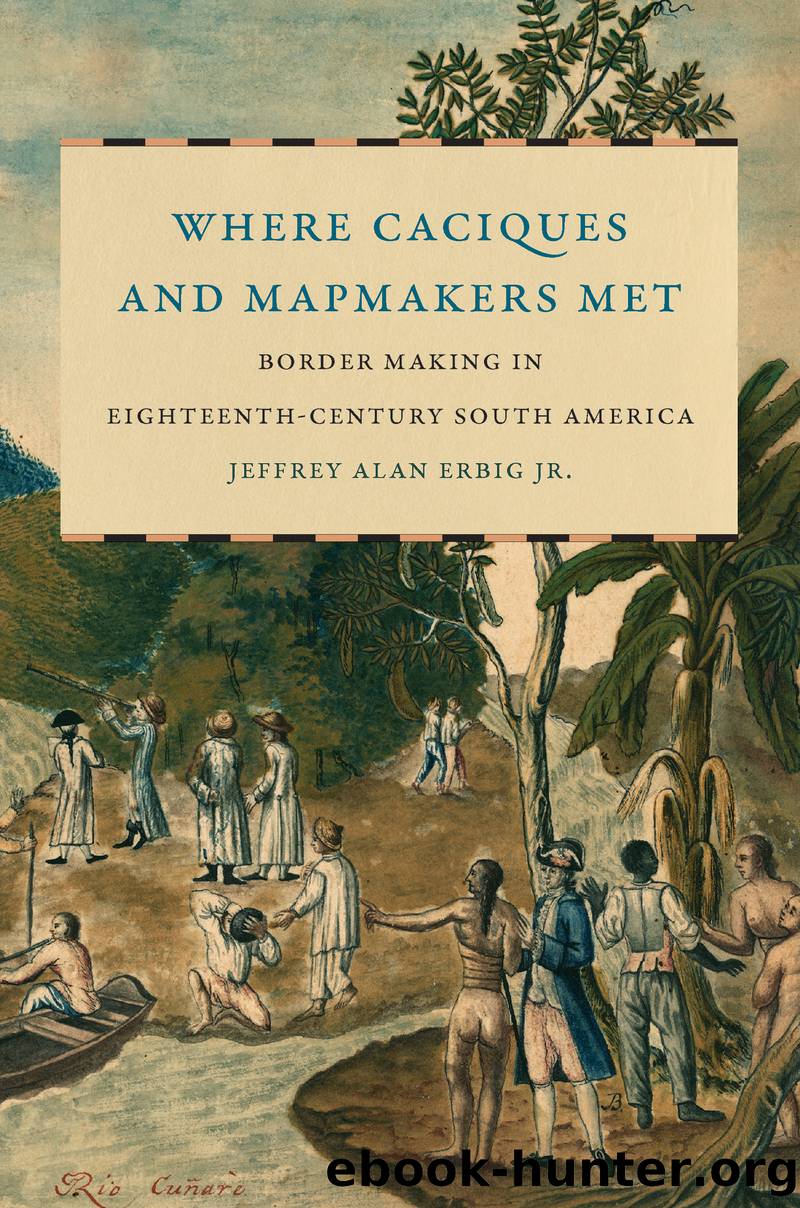Where Caciques and Mapmakers Met by Erbig Jeffrey Alan;

Author:Erbig, Jeffrey Alan;
Language: eng
Format: epub
Publisher: University of North Carolina Press
The End of the Line
Whereas the creation of an interimperial border intensified captive taking and movement between settlements and tolderías, the border’s dissolution in the early nineteenth century ultimately led to the demise of tolderías that remained in the countryside. Late-eighteenth-century border making had provided opportunities for certain caciques and tolderías, but these benefits dissipated during the first three decades of the nineteenth century, as local rejection of imperial authority and the subsequent wars of independence undermined the border’s legal weight. Once the border failed to restrict the movements of imperial agents, and alliances predicated on the border no longer guided imperial action, lands near the border became increasingly uninhabitable for tolderías. Tolderías’ capacity to traverse and move livestock across the interimperial division ceased to be unique, leaving them exposed to an increasing amount of violence and bereft of economic opportunities. As caciques’ success and their tolderías’ survival had become intimately tied to borderline territorialities, the rupture of these arrangements undermined both. By 1834, tolderías disappeared altogether from written records.
This process began with the dissolution of the San Ildefonso line in 1801. That year, Charrúa and Minuán tolderías expelled Guaraní ranchers and Spanish settlers from their lands, after which Portuguese forces invaded and annexed the Siete Pueblos, Batoví, Santa Tecla, and other Spanish settlements along the border. This regional fighting took place within the broader imperial context of the War of the Oranges, which pitted Spain and France against Portugal and placed their South American borderlines in abeyance. Given that the war had ended and Iberian diplomats had signed the Treaty of Badajoz by the time of the tolderías’ and Portugal’s advancements in the Río de la Plata, colonial officials in the region were left to reconcile the incongruence between the extant San Ildefonso line and the new on-the-ground settlement patterns. Although the Treaty of Badajoz did not directly reference the Treaty of San Ildefonso, it promised Portugal “the conservation of its states and dominions” (Article 9) and obliged the Iberian crowns to “renew their treaties of defensive alliance” (Article 10).61 Following the model set forth in the treaties of Madrid and San Ildefonso, regional officials deployed the concepts of uti possidetis and natural limits to reestablish a borderline in the Río de la Plata.62 Yet unlike those earlier accords, tolderías’ were taken into account when justifying the border’s adjusted location.
Given that many of Portugal’s newly claimed lands had been controlled by tolderías when the fighting broke out—specifically those south of the Río Ibicuí—Charrúas and Minuanes were thrust into regional debates about territorial possession, sovereignty, and Native autonomy. The governor of the Portuguese captaincy of Rio Grande declared that those lands “were abandoned by the Spanish nation before [the war], due to hostilities from Charrúa and Minuán Indians, [and] were explored during the war by our [Portugal’s] repeated patrols … and also by militiamen, natives, and those undomesticated Indians who … are declared enemies of the Spanish.”63 This argument was built on a logic of occupation rights and Indigenous autonomy.
Download
This site does not store any files on its server. We only index and link to content provided by other sites. Please contact the content providers to delete copyright contents if any and email us, we'll remove relevant links or contents immediately.
| Africa | Americas |
| Arctic & Antarctica | Asia |
| Australia & Oceania | Europe |
| Middle East | Russia |
| United States | World |
| Ancient Civilizations | Military |
| Historical Study & Educational Resources |
Cat's cradle by Kurt Vonnegut(13851)
Pimp by Iceberg Slim(12920)
Underground: A Human History of the Worlds Beneath Our Feet by Will Hunt(11247)
4 3 2 1: A Novel by Paul Auster(11027)
The Radium Girls by Kate Moore(10900)
American History Stories, Volume III (Yesterday's Classics) by Pratt Mara L(4819)
Perfect Rhythm by Jae(4616)
Wiseguy by Nicholas Pileggi(4577)
The Fire Next Time by James Baldwin(4336)
Paper Towns by Green John(4162)
A Higher Loyalty: Truth, Lies, and Leadership by James Comey(4024)
Pale Blue Dot by Carl Sagan(3993)
The Mayflower and the Pilgrims' New World by Nathaniel Philbrick(3905)
The Doomsday Machine by Daniel Ellsberg(3725)
Too Much and Not the Mood by Durga Chew-Bose(3689)
Killers of the Flower Moon: The Osage Murders and the Birth of the FBI by David Grann(3602)
The Borden Murders by Sarah Miller(3580)
The Sympathizer by Viet Thanh Nguyen(3451)
Killing England by Bill O'Reilly(3447)
